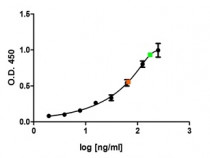ARG23067
anti-Apolipoprotein E antibody [WUE-4]
anti-Apolipoprotein E antibody [WUE-4] for ELISA,Western blot and Human,Mouse
Overview
| Product Description | Mouse Monoclonal antibody [WUE-4] recognizes Apolipoprotein E Mouse anti Human Apolipoprotein E antibody, clone WUE-4 recognizes an epitope within amino acids 140-160 of human apolipoprotein E (Apo-E), a major component of very low-density lipoproteins (VLDLs). Apo-E is the principle apolipoprotein in the central nervous system, and is secreted by most organs into the plasma, playing a vital role in the binding, internalization and catabolism of triglyceride-rich lipoprotein constituents.Apo-E acts as a ligand for both the specific apo-E receptor (chylomicron remnant) of hepatic tissues, and the apoB,E (LDL) receptor. Three isoforms of Apo-E have been identified, ApoE2, E3 and E4, and have been linked with various disorders. ApoE2 has been shown to bind LPL receptors with low affinity, resulting in increased plasma cholesterol and triglyceride levels, and thereby an increased risk in cardiovascular disorders. ApoE4 is a known high risk factor for Alzheimers disease, and in particular late onset Alzheimer disease 2 (AD2), whilst ApoE3 is the most common isoform, and considered the normal/natural Apo-E genotype.Mouse anti Human Apolipoprotein E antibody, clone WUE-4 has been shown to inhibit Apo-E mediated binding of lipoproteins to the apoB,E cell receptor (Krul et al. 1998). |
|---|---|
| Tested Reactivity | Hu, Ms |
| Tested Application | ELISA, WB |
| Host | Mouse |
| Clonality | Monoclonal |
| Clone | WUE-4 |
| Isotype | IgG1 |
| Target Name | Apolipoprotein E |
| Antigen Species | Human |
| Immunogen | Purified ApoHDL fraction. |
| Conjugation | Un-conjugated |
| Alternate Names | Apolipoprotein E; Apo-E; APO-E; LPG; AD2; LDLCQ5 |
Application Instructions
| Application Suggestion |
|
||||||
|---|---|---|---|---|---|---|---|
| Application Note | WB: This product detects a major band of approximately 34-36kDa in human liver cell lysates. * The dilutions indicate recommended starting dilutions and the optimal dilutions or concentrations should be determined by the scientist. |
Properties
| Form | Liquid |
|---|---|
| Purification | Purification with Protein G. |
| Buffer | PBS and 0.09% Sodium azide |
| Preservative | 0.09% Sodium azide |
| Concentration | 1 mg/ml |
| Storage Instruction | For continuous use, store undiluted antibody at 2-8°C for up to a week. For long-term storage, aliquot and store at -20°C or below. Storage in frost free freezers is not recommended. Avoid repeated freeze/thaw cycles. Suggest spin the vial prior to opening. The antibody solution should be gently mixed before use. |
| Note | For laboratory research only, not for drug, diagnostic or other use. |
Bioinformation
| Database Links | |
|---|---|
| Gene Symbol | APOE |
| Gene Full Name | apolipoprotein E |
| Background | The protein encoded by this gene is a major apoprotein of the chylomicron. It binds to a specific liver and peripheral cell receptor, and is essential for the normal catabolism of triglyceride-rich lipoprotein constituents. This gene maps to chromosome 19 in a cluster with the related apolipoprotein C1 and C2 genes. Mutations in this gene result in familial dysbetalipoproteinemia, or type III hyperlipoproteinemia (HLP III), in which increased plasma cholesterol and triglycerides are the consequence of impaired clearance of chylomicron and VLDL remnants. Alternative splicing results in multiple transcript variants. [provided by RefSeq, Nov 2014] |
| Function | Mediates the binding, internalization, and catabolism of lipoprotein particles. It can serve as a ligand for the LDL (apo B/E) receptor and for the specific apo-E receptor (chylomicron remnant) of hepatic tissues. [UniProt] |
| Calculated MW | 36 kDa |
| PTM | Synthesized with the sialic acid attached by O-glycosidic linkage and is subsequently desialylated in plasma. O-glycosylated with core 1 or possibly core 8 glycans. Thr-307 and Ser-314 are minor glycosylation sites compared to Ser-308. Glycated in plasma VLDL of normal subjects, and of hyperglycemic diabetic patients at a higher level (2-3 fold). Phosphorylated by FAM20C in the extracellular medium. |
Images (2) Click the Picture to Zoom In
-
ARG23067 anti-Apolipoprotein E antibody [WUE-4] ELISA image
ELISA: Human apolipoprotein E detected with ARG23067 anti-Apolipoprotein E antibody [WUE-4] followed by Rabbit F(ab')2 anti Mouse IgG (HRP).
-
ARG23067 anti-Apolipoprotein E antibody [WUE-4] ELISA image
Sandwich ELISA: Human apolipoprotein E using ARG23067 anti-Apolipoprotein E antibody [WUE-4] as a capture reagnt and biotinylated Goat anti Human Apolipoprotein E as a detection reagent with purified apolipoprotein E as antigen. Detection is with Streptavidin HRP. A serum sample 1/150 (green) and a plasma sample 1/150 (orange) are shown.







